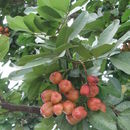en
names in breadcrumbs


Blighia is a genus of four species of flowering plants in the soapberry family, Sapindaceae, native to tropical Africa from Guinea east to Kenya. The fruit is partly edible, with the Ackee (B. sapida) being grown commercially for fruit production. The genus is named for Captain William Bligh (formerly of HMS Bounty), who brought samples back to England.
The species are evergreen trees growing to 10–20 metres (33–66 ft) tall, with pinnate leaves. The flowers are produced in small panicles. The fruit is an oval capsule 4–8 centimetres (2–3 in) long containing three seeds, each surrounded by an edible fleshy yellow aril, and a thick, leathery orange or red skin; the fruit apart from the aril is very poisonous.
Blighia is a genus of four species of flowering plants in the soapberry family, Sapindaceae, native to tropical Africa from Guinea east to Kenya. The fruit is partly edible, with the Ackee (B. sapida) being grown commercially for fruit production. The genus is named for Captain William Bligh (formerly of HMS Bounty), who brought samples back to England.
The species are evergreen trees growing to 10–20 metres (33–66 ft) tall, with pinnate leaves. The flowers are produced in small panicles. The fruit is an oval capsule 4–8 centimetres (2–3 in) long containing three seeds, each surrounded by an edible fleshy yellow aril, and a thick, leathery orange or red skin; the fruit apart from the aril is very poisonous.